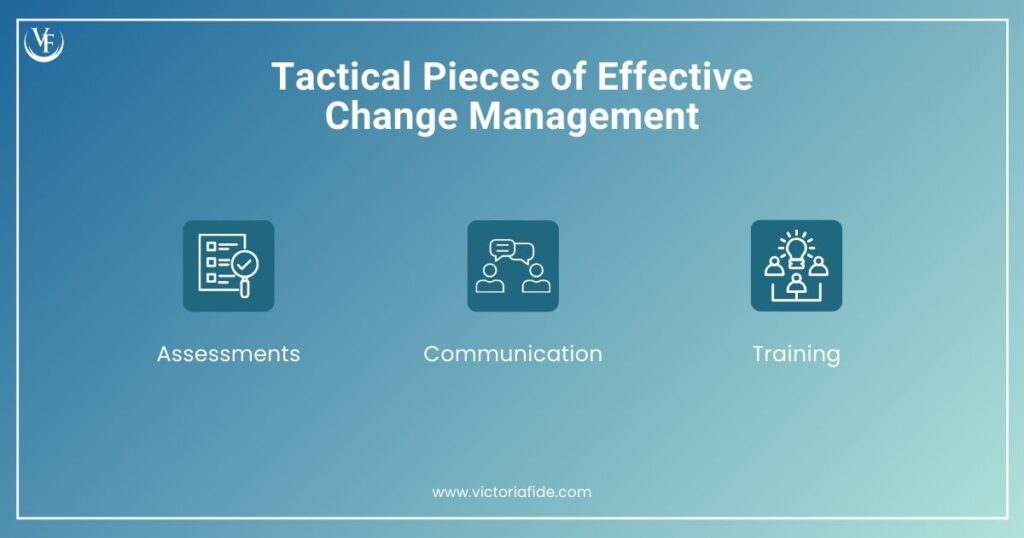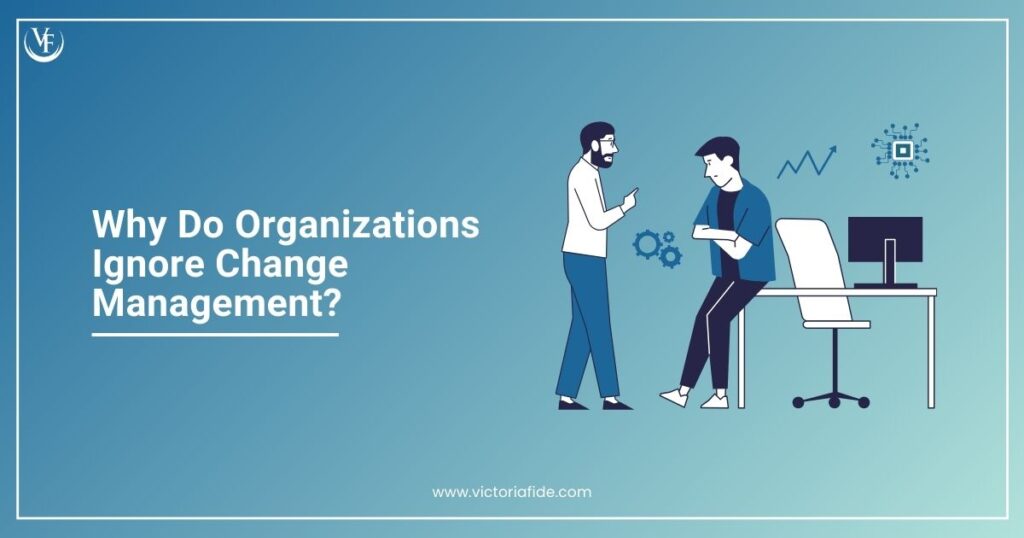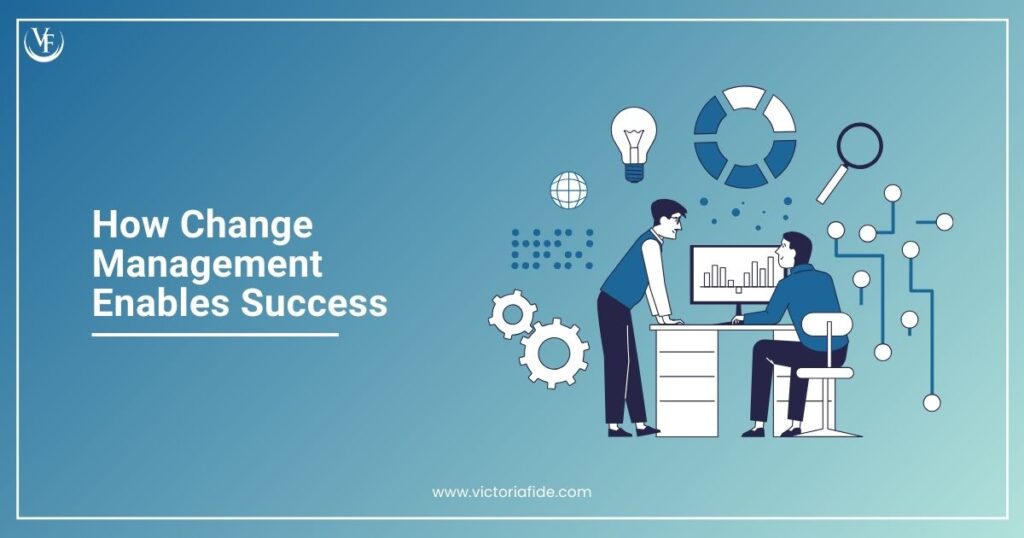
When the time comes for digital transformation, it is easy to minimize or even completely overlook change management, because after all, we are just talking about software… right? Not exactly. A change this big will have ripple effects across an entire organization and it is imperative to stay in front of it.
My hope is to help you understand what change management is both holistically and tactically, and then talk about why organizations might resist or ignore change management and what effects that has on the project and the organization as a whole. Finally, I want to dive into how embracing change management can be the missing piece to a successful digital transformation and positive organizational change.
Table of Contents
What is Change Management?
So, what is change management? Holistically, change management is about ensuring that when there is change to your processes, you have buy-in and support from all those who will be affected by the change. It is about earning buy-in from key team members as well as putting specific practices in place to mitigate risks and streamline user adoption. As we will explore in this article, earning meaningful support from the key players who will advocate for the change is vital to your success.
Ultimately, change management is about prioritizing the human element of the change. This is especially important when there is technology introduced as part of the business change. Technology can add significant complexity and – if not implemented in the right way through change management best practices – can experience significantly limited effectiveness.
It is important to take a structured approach to change management and follow a set of processes used to manage the transition from your current state to a new state when implementing new software in your organization. There are set processes that, when followed, will guide you from the onset of a digital transformation project all the way through the implementation, the go-live, and on to sustaining the change.

Some of the important tactical pieces of effective change management include the following:
Assessments
- Stakeholders Analysis: Identify and analyze all stakeholders who will be affected by the change, including end-users, managers, and IT staff.
- Risk Assessment: Identify potential risks and challenges associated with the software implementation.
- Identify and Train Change Champions: These are individuals within the organization who are enthusiastic about the change and can help promote it among their peers.
Communication
- Communication Planning: Develop a communication plan to keep all stakeholders informed about the upcoming changes.
- Open and Transparent Communication: Foster open communication channels to address concerns and keep everyone informed about the progress of the implementation.
Training
- Training Programs: Develop training programs to ensure that employees have the necessary skills to use the new software effectively.
- User Support: Provide ongoing support during and after the implementation to address any issues and answer questions.
Change management for software implementations is essential for minimizing resistance, ensuring a smooth transition, and maximizing the benefits of the new software for your organization. It involves a combination of strategic planning, effective communication, training, and ongoing support.
Why do Organizations Ignore Change Management?

It is very common for organizations to downplay or completely ignore change management practices when taking on a technology project. Why is that? While the specific factors can vary depending on the context, here are some of the most common reasons:
Lack of Awareness or Understanding: Sometimes, organizations may not fully understand the importance of change management or may be unaware of the potential benefits it can bring. This lack of awareness can lead to a disregard for established change management practices.
Overemphasis on Technology: In technology-driven environments, organizations might focus heavily on the technical aspects and underestimate the human side of the change. This oversight can result in neglecting change management processes.
Short-Term Focus: Organizations that prioritize short-term goals over long-term benefits may be inclined to skip or minimize change management efforts. They may see change management as an additional cost or time-consuming process that does not align with immediate objectives.
Leadership Resistance: If leaders within an organization resist change or do not see the value in change management, they may not prioritize or allocate resources to these practices. Leadership support is crucial for successful change management.
Complacency: Organizations that have experienced success without formal change management processes in the past may become complacent. They may believe that what worked before will work again, without recognizing the evolving nature of business environments.
Resource Constraints: Limited resources, including time, budget, and skilled personnel, can be a barrier to implementing comprehensive change management practices. Organizations facing resource constraints may prioritize other aspects of a project or initiative over change management.
Organizational Culture: Some organizational cultures may resist change or view it as a disruption. In these cases, there may be a reluctance to invest time and effort in change management, as the prevailing culture may not support it.
Perceived Ineffectiveness: If an organization has had negative experiences with change management in the past, leaders and employees may develop a perception that these practices are not effective. This can lead to a reluctance to invest in similar initiatives in the future.
Rapid Changes: In fast-paced industries or environments, organizations may feel pressured to implement changes quickly without dedicating sufficient time to formal change management processes. This urgency can lead to a bypass of established change management practices.
Resistance to Change Overall: Sometimes, there is a general resistance to the idea of change within an organization. This resistance can manifest at various levels, from individual employees to entire departments, making it challenging to implement effective change management.
Successful change management requires a holistic approach that addresses both the technical and human aspects of change. Organizations that recognize and address these common challenges are more likely to navigate change successfully.
The Consequences of Neglecting Change Management

We see repeatedly how organizations will place much lower priority on change management activities in favor of more pressing issues. And I get it – there are always seemingly bigger fish to fry. A software implementation is a big undertaking, and it can often feel like a fire fight. The thing about change management is that it is about preventing the biggest fires from starting in the first place!
What usually happens when change management practices are ignored or minimized? Of course, every case is different, but the following are some of the most common results:
Resistance and Low Adoption Rates: Without proper change management, employees may resist the new software due to fear of the unknown, lack of understanding, or concerns about job security. This can result in low adoption rates, where users continue to rely on old processes or avoid using the new software altogether.
Decreased Productivity: Poorly managed change can disrupt workflows and reduce productivity. If employees are not adequately trained on the new software or if there is insufficient support during the transition, it can lead to delays, errors, and a decrease in overall work efficiency.
Increased Costs: A lack of change management can contribute to unexpected costs. This may include the need for additional training sessions, extended implementation timelines, or the cost of fixing issues that arise due to inadequate planning. These factors can lead to budget overruns.
Employee Burnout: Implementing new software without considering the impact on employees’ workloads and stress levels can result in burnout. Increased stress, frustration, and dissatisfaction among employees can negatively affect morale and, ultimately, the organization’s overall performance.
Data Loss or Security Risks: Rushed or poorly planned software implementations may lead to data loss or compromise of sensitive information. Inadequate testing, improper configuration, or lack of security measures can expose the organization to potential cybersecurity threats.
Negative Impact on Customer Satisfaction: If the new software affects customer-facing processes and is not implemented smoothly, it can lead to disruptions in service delivery, errors in customer interactions, and a decline in overall customer satisfaction.
Missed Business Objectives: Without a well-defined change management strategy, the organization may fail to achieve the intended business objectives of the software implementation. This could include improvements in efficiency, cost savings, or competitive advantages.
Project Failure: In extreme cases, a lack of change management can contribute to overall project failure. This occurs when the implementation encounters insurmountable issues, exceeds budget constraints, or fails to deliver the expected benefits.
Damaged Organizational Culture: Poorly managed change can strain relationships among team members and damage the overall organizational culture. Employees may feel disconnected or disengaged, leading to long-term negative effects on teamwork and collaboration.
Reputation Damage: If the software implementation results in significant issues, such as data breaches, service disruptions, or financial losses, it can damage the organization’s reputation both internally and externally.
To mitigate these risks and achieve successful software implementations, organizations should prioritize effective change management practices that address the human and cultural aspects of change alongside the technical aspects.
How Change Management Enables Success

Now that we have talked about why organizations resist change management practices and what those effects are, let’s talk about what happens when an organization embraces change management. Here are several ways effective change management can contribute to the success of a software implementation or digital transformation:
Reducing Resistance: Change management helps identify potential sources of resistance to the new software and develops strategies to address them. By involving employees early in the process, addressing concerns, and communicating the benefits of the change, resistance can be minimized.
Increasing User Adoption: Proper change management includes comprehensive training programs that ensure employees have the necessary skills to use the new software effectively. This contributes to higher user adoption rates and faster integration of the software into daily workflows.
Improving Communication: A well-designed change management plan includes a robust communication strategy. Clear and transparent communication helps keep all stakeholders informed about the reasons for the change, the progress of the implementation, and any adjustments to the plan.
Managing Expectations: Change management helps set realistic expectations for the software implementation. This includes communicating both the benefits and challenges of the new software, managing timelines, and addressing any misconceptions that may arise among employees.
Minimizing Disruptions: Change management aims to minimize disruptions to ongoing business operations. Through careful planning, phased rollouts, and risk assessment, the organization can reduce the likelihood of unexpected issues and ensure a smoother transition to the new software.
Enhancing Employee Engagement: Engaged employees are more likely to embrace change. Change management practices, such as involving employees in decision-making processes and recognizing their contributions, contribute to a positive and engaged workforce.
Ensuring Ongoing Support: Change management extends beyond the initial implementation phase. It includes provisions for ongoing support and feedback mechanisms to address any issues that arise after the software is in use. This ensures that the organization can quickly resolve problems and adapt to any evolving needs.
Aligning with Business Objectives: Effective change management ensures that the software implementation aligns with the broader business objectives of the organization. By focusing on strategic goals, the implementation is more likely to deliver the intended benefits and contribute to the organization’s overall success.
Enhancing Organizational Culture: Change management considers the cultural aspects of the organization and seeks to align the new software with existing values and norms. This helps preserve a positive organizational culture during the transition.
Monitoring and Continuous Improvement: Change management involves monitoring key performance indicators (KPIs) to assess the success of the implementation. Continuous improvement strategies allow the organization to learn from the process, address any shortcomings, and refine strategies for future changes.
Mitigating Risks: By conducting thorough risk assessments and developing mitigation strategies, change management helps the organization anticipate and address potential challenges, reducing the likelihood of project failure.
Ensure Positive Change by Prioritizing Change Management
In summary, change management helps minimize resistance, increase user buy-in, and facilitate a smooth transition by addressing employee concerns, providing effective training, and maintaining clear communication. By prioritizing change management, you can enhance employee engagement, reduce disruptions, align the transformation effort with business objectives, and ultimately maximize the benefits of your digital transformation and ensure a positive change.
If you’re ready to reap the rewards of change management, contact us for a free consultation. Victoria Fide walks our clients through the end-to-end process of digital transformation, and our proven Process for Transformational Change incorporates specific activities designed to devise a change management strategy that will serve you and your team in specific and effective ways.
Transformation is not easy, but it doesn’t have to be impossible. Take control of your project’s success today and schedule a free 30-minute consultation to find out how Victoria Fide can equip you for transformational success.

About the Author
Skylar Stubbs is Project Manager at Victoria Fide and has been leading projects for over 6 years across multiple industries. Skylar is passionate about utilizing technology to enhance work and facilitate more streamlined processes that benefit everyone across an organization. His favorite part of the client journey is being able to help others find better ways to solve business problems and ultimately make lasting, positive organizational change.
